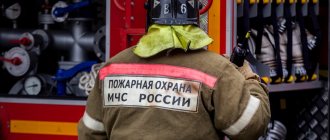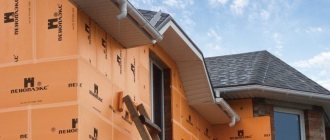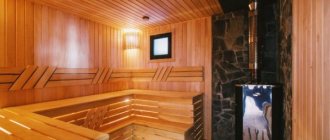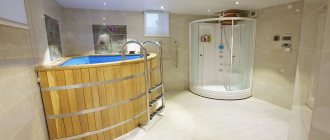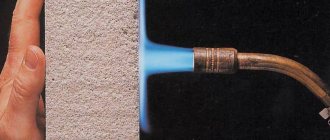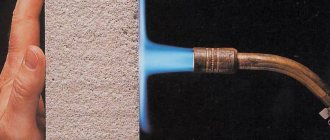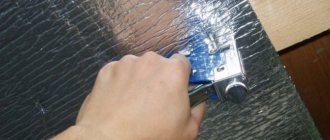Textiles are widely used in industry and everyday life, performing protective and decorative functions, demonstrating good consumer properties. In many situations, common sense considerations and the need to comply with safety regulations require special care in the selection of materials.
A good help for ensuring fire resistance in home and industrial premises is non-flammable fabric, of which there are several varieties. Information about the properties of canvases, understanding their structure and features will allow you to make the right choice of fire-resistant purchase.
For welding
Only from us: you can buy non-flammable fabric for welding from 1 m2 and thread from 10 m/line. Prices from 900 rub. There are more than 5000 m2 of fabrics in stock in Moscow - delivery throughout Russia.
The quality of fire-resistant fabrics is of the highest world level.
The best Russian and foreign brands.
| Coating | Without cover |
| Maximum temperature, *C | 400 |
| Thickness, mm | 0,29 |
| Color | Golden (yellow) |
| Weight, g/m2 | 250 |
Base: Aramid Maximum application temperature.
| Coating | Without cover |
| Maximum temperature, *C | 400 |
| Thickness, mm | 0,35 |
| Color | Golden (yellow) |
| Weight, g/m2 | 300 |
Base: Aramid Maximum application temperature.
| Coating | Without cover |
| Maximum temperature, *C | 400 |
| Thickness, mm | 0,44 |
| Color | Golden (yellow) |
| Weight, g/m2 | 350 |
Base: Aramid Maximum application temperature.
| Coating | Without cover |
| Maximum temperature, *C | 400 |
| Thickness, mm | 1,5 |
| Color | Golden (yellow) |
| Weight, g/m2 | 680 |
Base: Aramid Maximum application temperature.
| Coating | Without cover |
| Maximum temperature, *C | 1400 |
| Thickness, mm | 1,3 |
| Color | Grey |
| Weight, g/m2 | 1150 |
Silica fabric N_1150SF_XT consists of interwoven silica fibers and is made from .
Silica fabric N_1250SF_XT consists of interwoven silica fibers and is made from .
| Coating | Without cover |
| Maximum temperature, *C | 1200 |
| Thickness, mm | 0,75 |
| Color | Grey |
| Weight, g/m2 | 600 |
Silica fabric N_600SF consists of interwoven silica fibers and is made from cheese.
| Coating | Polyurethane |
| Maximum temperature, *C | 200 |
| Thickness, mm | 0,75 |
| Color | Dark grey |
| Weight, g/m2 | 610 |
Silica fabric N_610SF_PU with polyurethane coating is composed of interwoven silica fibers.
| Coating | Without cover |
| Maximum temperature, *C | 1400 |
| Thickness, mm | 1 |
| Color | Grey |
| Weight, g/m2 | 880 |
Silica fabric N_880SF_XT consists of interwoven silica fibers and is made from s.
| Coating | Vermiculite |
| Maximum temperature, *C | 850 |
| Thickness, mm | 1,3 |
| Color | Grey |
| Weight, g/m2 | 1260 |
Base: Fabric E-glass Width: 10.
| Coating | Aluminum |
| Maximum temperature, *C | 200 |
| Thickness, mm | 0,4 |
| Color | Silver |
| Weight, g/m2 | 460 |
Base: Fabric E-glass Width: 10.
| Coating | Silicone |
| Maximum temperature, *C | 250 |
| Thickness, mm | 0,42 |
| Color | Gray-silver |
| Weight, g/m2 | 510 |
Base: Fabric E-glass Width: 15.
| Coating | Aluminium/Silicone |
| Maximum temperature, *C | 200 |
| Thickness, mm | 0,72 |
| Color | Silver |
| Weight, g/m2 | 650 |
Base: Fabric E-glass Width: 10.
| Coating | Vermiculite |
| Maximum temperature, *C | 1100 |
| Thickness, mm | 1,3 |
| Color | Brown |
| Weight, g/m2 | 1250 |
Base: Fabric E-glass Width: 10.
| Coating | Vermiculite |
| Maximum temperature, *C | 1100 |
| Thickness, mm | 0,62 |
| Color | Brown |
| Weight, g/m2 | 620 |
Base: Fabric E-glass Width: 10.
We offer you the ideal workwear in which to work comfortably, pleasantly and safely. We sew only from durable, high-quality materials that are durable for protection and comfortable to wear. All fabrics are not only comfortable, but also safe for humans, and also meet the necessary sanitary standards.
This is interesting: Fire retardant pastes: purpose, types and scope of application
How to order FERUM materials
Just contact us
- Call
- Request a call back
- Write
We'll help you fill out an application for a quote.
- We will find out all the necessary parameters for fire protection of your facility
Let's calculate the required amount of material
- Based on your parameters
- Taking into account fire safety standards
We will ship from warehouse or make to order
- From 1 day
- Pickup or delivery
- Guarantee
The fire-resistant fabric Ferum-MEI developed by us for removable insulation is successfully used in many industries for the production of unique protective products and protective covers, flexible impermeable inserts. Heat-resistant fabric can also be used to protect pipelines, for welding work and in many other cases.
The heat-resistant fabric ferum-MEI does not burn, it is waterproof and easy to work with - cutting and sewing.
Meets the requirements of clause 221 of PPB SRS 01-2009 “Fire safety rules on ships under construction and repair”, PUE “Rules for the installation of electrical installations” clause 7.6.34.
Varieties of fire-resistant, heat-resistant fabrics
Carbon fibers
Carbon fiber is a fabric made from thin threads formed by carbon atoms. It is created in a special way, which results in high tensile strength, high tension force, low specific gravity and low coefficient of thermal expansion, chemical inertness.
Carbon fibers are available in a variety of forms: stapled filaments, continuous filaments, woven and non-woven materials . But the most common types are strands, yarn, roving, and non-woven canvases. They are used to create various types of heat-resistant fabrics. There are also carbon sheets that can themselves be used to create special materials.
Carbon fibers can withstand temperatures of 300-370C0 , and high chemical resistance . It is also possible to obtain this material with high electrical properties.
Carbon fibers are used in construction, medicine, the creation of special clothing, footwear, and in a variety of chemical processes .
Quartz fibers
Quartz fibers are obtained by drawing from rods , because quartz does not melt even at very high temperatures. In industry, impurities of other oxides are added to quartz fibers , which makes these fibers easier to use and form a variety of products.
Quartz fibers are widely used in the chemical and electrical power industries due to their high chemical and thermal resistance. The melting point of pure quartz fibers is 1750 C0. They can withstand short-term temperatures of 2000 C0. This fabric can withstand temperatures of 1400 C0 and is considered fireproof. .
Asbestos fabric
Asbestos fabric is unique in its properties. It has high heat resistance up to 500C0 . Most often used in construction. For greater strength of cement, in the production of heat-resistant and durable pipes, sheets, pebbles . Also used to create asphalt, plastics, scraps, insulators .
Asbestos is famous for its excellent electrical insulation, heat insulation and fire resistance properties . Therefore, it is used to create hermetically sealed connections or for thermal insulation protection.
Asbestos fabrics are used as thermal insulation and lining material when sewing clothing for special purposes. For example, for firefighters or metallurgists. After all, asbestos can withstand very high temperatures; it can be used to insulate a stove or other heating devices.
Unfortunately, asbestos fabrics can be dangerous for humans , because the dust that is released from this material can remain in the lungs and cause chronic bronchitis, asbestosis or even lung cancer. But this only happens when asbestos fibers are used openly.
Aramid fabric
Aramid fiber is a chemical fiber that has high strength, heat resistance, elasticity, and resistance to various chemical reagents .
Now there are three types of aramid fibers:
- para-aramids,
- meta-aramids,
- aramid copolymers.
Para-aramids have increased heat resistance. Holding temperature for aramid fibers:
- Para-aramids - Tavron, Kevlar, SVM, Terlon from 250 to 370C0.
- Meta-aramids - Nomex, Arcelon from 370 to 400C0 .
- Aramid-kermel copolymers up to 350C0.
There are also a variety of types of aramid fabrics. It is worth paying attention to heat-resistant ones: Tvaron, Kevlar, SVM, Terlon.
Aramid fabrics do not burn or melt, are very durable and weigh little. At high temperatures they retain their properties. Military special clothing and thermal clothing are made from aramid fabrics. After all, aramid also has thermal insulation properties.
Tarpaulin
Tarpaulin is a thick canvas impregnated with special fire-resistant, water-repellent, anti-rot compounds . If fire-resistant impregnation has been carried out, the material becomes yellow.
Tarpaulin is used to make workwear, footwear, building materials, clothing and footwear for the army. Also, suits for welders and firefighters are made from tarpaulin.
The tarpaulin can withstand temperatures from -30 to +90 degrees . In direct contact with fire, it does not melt for about a minute.
Silica fabric
Silica fabric is an excellent thermal insulation material. It is a prototype of asbestos, suitable for higher temperatures. And it is a fire resistant fabric. Withstands up to 1000 C0 . It has high chemical resistance and is not susceptible to mold.
Silica fabrics are used in mechanical engineering, the petrochemical industry, and for the manufacture of firefighter clothing.
Trade marks
There are many types and brands of both completely non-flammable and fire-resistant fabrics on the market:
- Tend building fabric is a non-flammable material that corresponds to group NG, hazard class KM0. It is used as a steam-, wind-, and heat-insulating material for ventilated facades, roofs, and floors of buildings. The material is resistant to moisture, aggressive environments, sudden temperature changes, and exposure to ultraviolet rays.
- Thermally resistant silica fabric KT-11 . SiO2 content – up to 99%. The main qualities are fire resistance up to 1200℃ (long-term), strength, dielectric, environmental properties, which makes it a multifunctional material.
- Basalt fabric TBK-100 coated with metal foil. The operating temperature range is from – 200 to + 650℃, melts at 1100℃. Used in the production of rolled roofing materials as thermal insulation.
- Izoltex fabric is made from fiberglass. Operating temperature – up to 560℃, maximum short-term – 700℃. It has excellent thermal insulation properties, is chemically inert to strong organic and mineral acids, concentrated solutions of alkalis. An excellent substitute for asbestos fabrics, used in construction and various industries.
- Kevlar, Arcelon, Terlon, Kermel, Nomex are various trademarks, names of types of aramid fabrics that are thermally resistant in the range from 250 to 400℃.
For fire-retardant treatment of natural fabrics, the following impregnations are used: “Negorin-fabric”, “OGNEZA-PO”, “Nortex”, “ANTAL TM”, which do not change their appearance, do not reduce strength, and do not have an unpleasant odor.
Important: for each batch of such products, regardless of the volume of the batch, the customer (buyer) has the right to demand a fire safety compliance certificate, which specifies all the necessary characteristics.
Wool
Which fabrics are the most fire resistant?
Wool is generally considered the most fire-resistant natural fiber because it is difficult to ignite and flames are often extinguished in the fibers. Natural fibers such as silk, cotton and wool are more susceptible to fire than manufactured fibers, but fabric manufacturing techniques can improve their fire resistance. Natural fibers can be treated with a chemical solution that improves fire resistance. When a natural fiber material is made with a tight weave, the material provides improved fire resistance.
Acrylic, Polyester and Nylon
Which fabrics are the most fire resistant?
Synthetic acrylic, polyester, and nylon fabrics can be dangerous when they burn because the materials can melt and cause burns to the skin when used as clothing fabrics. Despite this danger, these synthetic fabrics are considered fire-resistant fabrics because they resist fire at significantly higher temperatures than natural fibers. Synthetic materials can also be treated with fire-resistant chemicals to increase their ability to withstand high temperatures.
This is interesting: Refractory (fire-resistant) concrete: composition and characteristics
Where is high-temperature thermal insulation used?
In construction practice, high-temperature insulation finds many applications. Moreover, the necessary thermal insulation characteristics will vary in each specific case.
High temperature insulation of a heating boiler or furnace. This is especially true for models running on solid fuel. Often their surfaces heat up to significant values. Therefore, to insulate them, materials that can withstand the highest temperatures are used (fiber cement boards, mineral wool, etc.
Chimney protection. Here, the insulating materials must be flexible to simplify installation. Rolled materials (metal foil, mineral wool) best meet this requirement.
Requirements
At the time of writing, there are no national standards defining the production of non-flammable, fire-resistant fabrics that do not burn well. Therefore, companies that produce this group of textile materials themselves develop technical specifications that regulate the entire production process.
In addition, specifications are a mandatory document provided by the manufacturer for certification fire tests of serial products, necessary to obtain a fire safety certificate.
Testing non-flammable fabric for flammability
Requirements and test methods relating to the main characteristic - the flammability of fabrics - are set out in the following fire safety standards:
- GOST R 50810-95, which classifies decorative textile materials based on the flammability test method.
- NPB 257-2002. This document regulates testing methods for flammability, smoldering, flame sustained and residual combustion of textile materials - curtains, drapes, bedding, upholstery.
Such tests involve exposing selected tissue samples to the flame of a laboratory gas burner or a smoldering cigarette; and the results obtained objectively show how well their fire protection treatment was carried out with fire retardant solutions.
Carbon non-flammable sheets
All natural fabrics are made from organic raw materials, which means they contain carbon atoms, in addition to which there are large quantities of other atoms: oxygen and hydrogen.
The presence of the latter structural units significantly increases the flammability of any product. Almost two centuries ago, it was possible to synthesize non-flammable fibers consisting only of carbon atoms. The high heat resistance of the filaments made it possible to use them in incandescent lamps.
Subsequently, the technology was improved many times, leading to the development of an easy-to-implement production process that allows the use of a variety of organic raw materials as a carbon source.
Now carbon fibers are made from viscose and polyacrylonitrile, long and short, in the form of staple elements. Fire-resistant fabrics are produced by weaving using classical weaving methods; in addition, non-woven carbon heat-resistant products are presented on the market.
Non-flammable fabrics made from carbon filaments have great resistance to stretching, chemical influences, low weight and the ability to expand when the temperature rises. The maximum temperature they can withstand reaches 370℃.
Quartz
The fibers are obtained from drawn quartz of natural origin by heating to high temperatures.
This process is labor-intensive, but the result is impressive with its highly expressed fire-retardant properties. The non-flammable material produced by this method contains up to 99% silicon oxide, is very similar to fiberglass, and can withstand heating up to 1400 ℃ without changing its structure and properties. Quartz non-flammable material is used in the chemical and energy industries for technical purposes and for making protective clothing. For a short time, the material can withstand heating up to 2000 ℃.
Modernized quartz fabrics, which have greater heat resistance, were used at the end of the last century to cover the spacesuits of American astronauts, as the best option for fire-fighting materials existing at that time.
The main advantage of the products is absolute safety for humans, which distinguishes them from some other types of non-flammable textile products.
Asbestos
Asbestos materials are made from non-flammable natural silicates with thin fibers.
Asbestos tolerates heat up to 500 ℃, has great insulating properties, and is widely used in industry for the production of heat-resistant building materials.
The fire resistance of asbestos fabrics is great, but they must be used with great care. Using it as a nightmare to quickly extinguish fires is quite justified, but wearing clothes made of fabrics with asbestos is unacceptable for a person.
It has been proven that inhalation of asbestos microparticles initiates the appearance of formations, while the entry of fibers into the body through the food tract does not cause consequences. The risk of harmful effects can be reduced by introducing anti-dust additives that prevent particles from entering the environment. Additional processing increases the price of asbestos products, significantly increasing their safety.
Fire-retardant and non-combustible coatings
Thick-layer coatings - mastics, plasters and fire retardant pastes. According to the mechanism of protective action, they can be classified as heat-insulating, but at the same time they differ in thickness, fire resistance limits and composition.
Mastics and pastes are materials based on silicate “liquid” glass, with various non-flammable fillers - maximum fire resistance limit is 90 minutes (R90). With a covering layer thickness from 8 to 20 mm.
Plaster compositions - gypsum, aluminous and pozzolanic cements with various types of fillers are used as a binder, such as diatomite and perlite, expanded or non-expanded vermiculite, volcanic pumice, tripoli, volcanic tuff, etc. Fibrous fillers are also used for reinforcement: kaolin wool and other mineral fibers.
These compositions provide the highest fire resistance limits, up to 4 hours (R240) , but have a number of disadvantages - high consumption, heavier load-bearing structures, complexity of application, low wear resistance.
Structural fire protection is a combination of several specialized non-combustible materials (plates, canvas, mats, etc.) with fire-retardant paints or mastics. The advantage of these fireproof structures is a high fire resistance limit, relatively low weight, ease of installation, and do not depend on the specified metal thickness. The main disadvantage is the inconvenience of installation in hard-to-reach places.
Penetrating - fire-retardant impregnations consist of a non-flammable binder and various fire retardants with functional additives. Increases the fire resistance of almost any material. Can be applied to wood, fabric, cardboard, concrete, brick. Penetrating into the base, the product creates an impenetrable barrier that partially absorbs heat without transferring it to the base material. Today, these types of coatings are used mainly for fire protection of wooden structures and fire-resistant impregnation of woven materials. The main advantage of these coatings is their high penetrating ability.
Fireproof (non-flammable) - as a rule, they are made on the basis of potassium “liquid” glass and other technical components (sands, fire retardants). This type of coating does not have fire-retardant properties, it is only a decorative non-flammable coating that prevents the passage of flame along its surface, as it is neutral to combustion.
has developed almost all types of fire-retardant and fire-resistant coatings, but our range includes only those that are most in demand by the market and are most effective. All products have passed real tests and have appropriate certificates.
Purpose
Fabric materials based on asbestos, due to its carcinogenic properties, are practically no longer used in the production of fire-retardant elements of overalls for firefighters and metallurgists, but are widely used as asbestos-technical, fire-resistant heat-insulating products, including in aggressive chemical environments.
Polyester, as well as some varieties of aramid fire-resistant fabrics, serve as the starting material for curtains used for the stage of theaters and clubs; for restaurants, hotels. Wherever there are a lot of people constantly or regularly, there is a possibility of draperies, drapes, curtains coming into contact with ignition sources.
On this topic ▼
Fire retardant impregnation: requirements and procedure for processing materials
Furniture manufacturers also use these types of fire-resistant fabrics as furniture upholstery, which cannot be set on fire by a fallen smoldering cigarette.
For mittens included in the sets of special clothing for firefighters, workers in hot shops of metallurgical and energy production, carbon, silica, basalt fire-resistant materials are used, as well as fiberglass, which is the surface layer of both hand protection means and workwear in general.
Special clothing and suits with fire-retardant treatment are also made from linen and cotton fabrics of high density and thickness of the material.
They are used by gas and electric welders, blacksmiths, boiler house workers, hot shop workers of other industries.
Treatment with fire-resistant coatings
Almost any material can be made heat-resistant due to fire-resistant impregnation, which contains non-flammable chemicals. As a rule, these are fire retardant compounds. They are also often used for wood processing. This treatment has a significant advantage: it does not last long at all, but at the same time it retains its properties only for a year, then it needs to be renewed.
You might be interested in Description of non-woven fabric: what kind of fabric is it, where and how is it used
Another drawback is that the product may be coated unevenly, so there may be stains in some places and an oily coating in others. When washing, the impregnation is gradually washed off, so items after water need to be treated more often than once a year.
The received product must be accompanied by a fire safety certificate.
Non-flammable form
What it is
Let us answer the question, what kind of fabrics are these that do not burn? Such materials primarily include the long-known, non-flammable asbestos fabric, used at temperatures up to 500℃. Made from the natural layered mineral asbestos, it does not contain combustible organic substances, therefore, in the full sense of the word, it is non-flammable.
On this topic ▼
Workwear and suits with fire retardant impregnation
The second type of fabric from which fire-resistant workwear for welding and protective suits for working in hot shops are made are high-density natural materials made from cotton and linen.
For example, tarpaulin fabric, additional resistance to direct contact with open fire, the high-temperature thermal effects of which is imparted by fire-retardant impregnation with various types of fire retardants.
This fabric is fire-resistant in its properties, as it is capable of resisting flames and high temperatures for a short period, which makes it possible to reliably protect a person wearing protective clothing made from it in the area of direct contact with negative influence factors.
In addition to these most famous examples, there are many other types of both flame retardant and fire resistant textile materials used in a wide variety of fields.
Fireproof fabric
Aramid
Aramid materials are a polymer product that has longitudinal and cross-linking of aromatic structures.
There are several options for connecting benzene rings, depending on which of them is implemented in a particular technology, the resulting fabric will have certain properties.
Reliable fire protection (resistance when heated to 370 ℃) is provided by para-aramid fabrics, the production of which can be carried out in various types of thread weave: waffle, satin, twill, plain.
Sometimes non-flammable aramid products are knitted and sold as rolled heat-resistant knitwear.
All types of products made from heat-resistant aramid are lightweight, high strength, and are used for sewing workwear and military uniforms; manufacturing of thermal insulation products.
Types of high-temperature thermal insulation
The division into types of high-temperature insulating materials is carried out according to the method of their production and the composition of the ingredients. Currently, on the market you can find both thermal insulation with a long history of use, as well as new products.
- Expanded clay. Bulk material has a rich history of use. Currently, it is most often used only as a filler for composite materials.
- Mineral wool. It is obtained by melting threads from mineral raw materials. It is gradually disappearing from the market due to its fragility and hygroscopicity.
- Foamed concrete. Due to the porous structure, it has a small thermal conductivity and weight.
- Basalt thermal insulation. Universal material. With good fire resistance, it also has sound insulating properties.
Basalt high temperature thermal insulation
There are also less common types: foam glass, high-temperature foams, etc. The specific choice of one or another type of high-temperature insulation should take into account operating conditions and economic feasibility.
Silica
Silica textiles are very similar in composition to quartz non-flammable fabrics, the difference lies in the lower content of silicon oxide, not exceeding 95%. The fabric provides fire protection at temperatures up to 1200 ℃, short-term exposure up to 2000 ℃.
The material is absolutely safe for humans and can be used for the production of filters, insulating and fire-resistant coatings; able to protect against radiation.
Oxygen index
The oxygen index is a fire safety characteristic of a material, which shows the minimum amount of oxygen per unit volume of insulation. According to the oxygen index, there are several flammability thresholds:
- 40% - composite polymers;
- 31% - fibrous and cellular non-flammable insulation;
- 20% - materials that burn well in air.
Polyester
Fibers and threads synthesized from polyesters become resistant to high temperatures when phosphorus compounds are added to the raw material.
The German brand labeled its products with the name Trevira. In the production of heat-resistant materials from organophosphorus threads, different types of weaving are used, as a result of which fabrics with non-flammable properties are produced, such as rep, voile, moleskin, jacquard, satin, velvet.
Fire-retardant velvet fabrics are needed more for beauty, combined with safety; moreover, moleskin, for example, demonstrates not only increased heat resistance, but also significant dust-proof properties.
Polyester flame retardant fabrics have a varied, beautiful appearance; have the following advantages:
- practicality;
- wear resistance;
- ability to maintain shape well;
- inertness to the action of the sun;
- hygiene;
- security.
When exposed to a fire zone, the fabric shrinks in size without melting and chars without emitting toxic gaseous products.
The materials are highly breathable, durable, and are used in medical institutions, hotel complexes, and vehicles.
Polyester non-flammable textiles are easily washed without changing properties in ordinary warm water with temperatures up to 40 ℃. Washing can be done both in a machine and in the usual manual way. Dry cleaning in specialized establishments that have the skills to work with such material is completely acceptable.
After wet processing, the products must dry well under natural conditions; subsequent storage is allowed at standard room temperatures and air humidity.
Wall cladding around the stove
When the wall is directly adjacent to the surface of the stove, it becomes very hot, which can lead to a fire. To avoid this, the wall is sheathed with non-combustible material. The cladding can be reflective or with cladding. When reflective, metal or galvanized sheets with heat-resistant insulation are used. From a health safety point of view, it is better to choose stainless steel, since zinc releases toxic substances when heated.
To cover the walls around the stove, you can use metal or galvanized sheets with heat-resistant insulation
First, mineralite insulation is attached to the wall at a distance of 2-3 cm, and a sheet of pre-polished stainless steel is placed on top. Heat rays are reflected from the shiny surface, and the heating of the wall is halved. In addition to cladding, cladding creates an aesthetically pleasing appearance. Drywall with the addition of fiberglass can serve well as a refractory material for cladding.
More information about protecting wooden walls:
The main fire-resistant sheet material for bathhouses and heating boilers is heat-resistant plasterboard.
But its use is not necessary if the distances to the walls established by the norm are observed:
- From brick stoves - at least 30 cm.
- From lined ones - at least 70 cm.
- From metal - at least 1 m.
If the stove is very close to the wall, additional protection will be required: one small spark or fallen ember can cause a fire.
Decorating the walls around the fireplace with non-combustible panels is a very convenient solution
This can be prevented by following a certain sequence of actions:
- The wall is covered with a vapor barrier film consisting of foil, polyethylene and kraft paper. For fastening, a metal profile or ordinary wooden blocks are used.
- Then comes the installation of insulation - foiled mineral wool, which must be laid in the sheathing so that it is on top, and the resulting joints should be sealed with tape.
- After this, any heat-resistant sheet material is attached to the sheathing with self-tapping screws using a sleeve.
- To give the wall an aesthetic appearance, a mesh is laid on the resulting structure, onto which ceramic tiles are glued.
Amateur stove-makers also have the following inexpensive way to save walls. You will need metal tubes that are empty inside and profile sheets for the roof. The tubes are attached to the wall, with profile sheets on them, then another similar layer. As a result, hot air moves between the wall and the floor in the space left during the installation process, and the wall does not heat up.
Application of impregnation
There is a completely different approach to the production of fire-resistant materials, based on the treatment of any canvas with special fire-retardant compounds.
Fire retardants are known for their ability to suppress combustion processes and are widely used for processing wood and other construction products.
The technology for the production of non-flammable impregnated fabrics is well established and requires low costs, which leads to an affordable price for non-flammable materials. However, such fabrics have disadvantages, which are that fire retardants remain effective only for a year . After this period, impregnation must be repeated.
The fixation of flame retardant compounds on the base does not always occur evenly, which can cause stains or streaks to form. Sometimes the surface becomes covered with an oily coating. When washing, fire retardant components are washed out even faster, so re-impregnation will need to be done more often.
High-quality non-flammable textile products are sold with a mandatory certificate, which indicates the main test indicators, the temperature range acceptable for operation, weight, dimensions of the product, methods of storage and care.
Considering the importance of providing fire protection for residential and industrial premises, you should purchase fire protection products only in specialized stores.
Right choice
The choice is based on the scope of application of the insulation. Thus, basalt wool is relevant for insulating roofs, walls, ceilings and facades, as fire protection for ventilation and building structures, pipelines, baths and saunas. Foam glass is an excellent non-flammable insulation for chimneys; it is appropriate to use it for insulating roofs, walls, ceilings and fire-resistant structures.
If you want to insulate an apartment with foam glass, then you need an L-shaped bracket, an anchor, which will help secure a layer of blocks to the plastered wall (ceiling). Fiberglass is applicable for insulating attics, roofs, walls, floors along joists, partitions and interfloor ceilings, saunas and baths, walls behind radiators of central heating systems.

